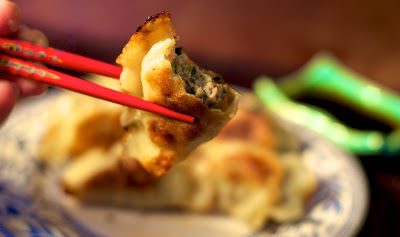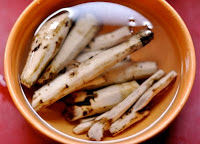I LOVE POTSTICKERS so much that—until recently—I had never cooked them at home. Make sense? They occupied a place in my mind that was beyond the kitchen, or at least my kitchen. They were enshrined, enshrouded, holy.
But the other day I came home with a big bag of wild fall watercress and decided it was time to expand the repertoire. (Remember, it’s important to find watercress upstream of livestock and development.)

The peppery flavor of this super robust autumn variety was intense. If you like arugula, you’ll love watercress. It’s a good match with either ground pork or tofu.
Meat Filling:
1 lb ground pork
2 loose cups watercress, finely chopped
3 green onions, finely chopped
1 tbsp Chinese rice wine
1 tsp sesame oil
1 tsp cornstarch
1/2 tsp salt
white pepper
Mix ingredients in a large bowl and set aside. Makes enough for 24 potstickers.
Vegetarian Filling:
1 14-oz package firm tofu, finely chopped
2 loose cups watercress, finely chopped
3 green onions, finely chopped
1 tsp dark soy sauce
1 tsp sesame oil
1 tsp cornstarch
1/2 tsp salt
white pepper
Mix ingredients in a large bowl and set aside. Makes enough for 24 potstickers.
Wrappers:
1 cup flour
1/4 tsp salt
1/2 cup boiling water
Mix flour and salt into large bowl. Measure out a 1/2 cup of boiling water and add to bowl of dry ingredients. Stir with wooden spoon until cool enough to work with hands. Knead 5 minutes over a lightly floured work surface until smooth. Divide into two equal balls. Roll each ball into a 12-inch snake. Slice each snake into 1/2-inch sections, about a dozen per snake. With a rolling pin, roll out each section into a round wrapper, about 3 inches in diameter. Makes about 24 wrappers.
To fill and cook potstickers:
1. Use a teaspoon to scoop a heaping amount of filling onto the middle of a wrapper. Fold over and pinch edges. Put aside. Repeat.
2. Add a 1/2 tablespoon of peanut oil to a large nonstick skillet over medium heat. Arrange a dozen potstickers in a single layer. Fry a couple minutes uncovered until golden brown on bottom. Drizzle a 1/2 cup of water into the pan and cover. Cook several more minutes, until water is absorbed and cooked off. At this point I like to flip the potstickers to lightly brown the other side before serving.
Makes about 24 potstickers. Serve with a dipping sauce of soy sauce, black vinegar, sesame oil, and hot oil. You can also add chopped scallion and ginger to the sauce.



































